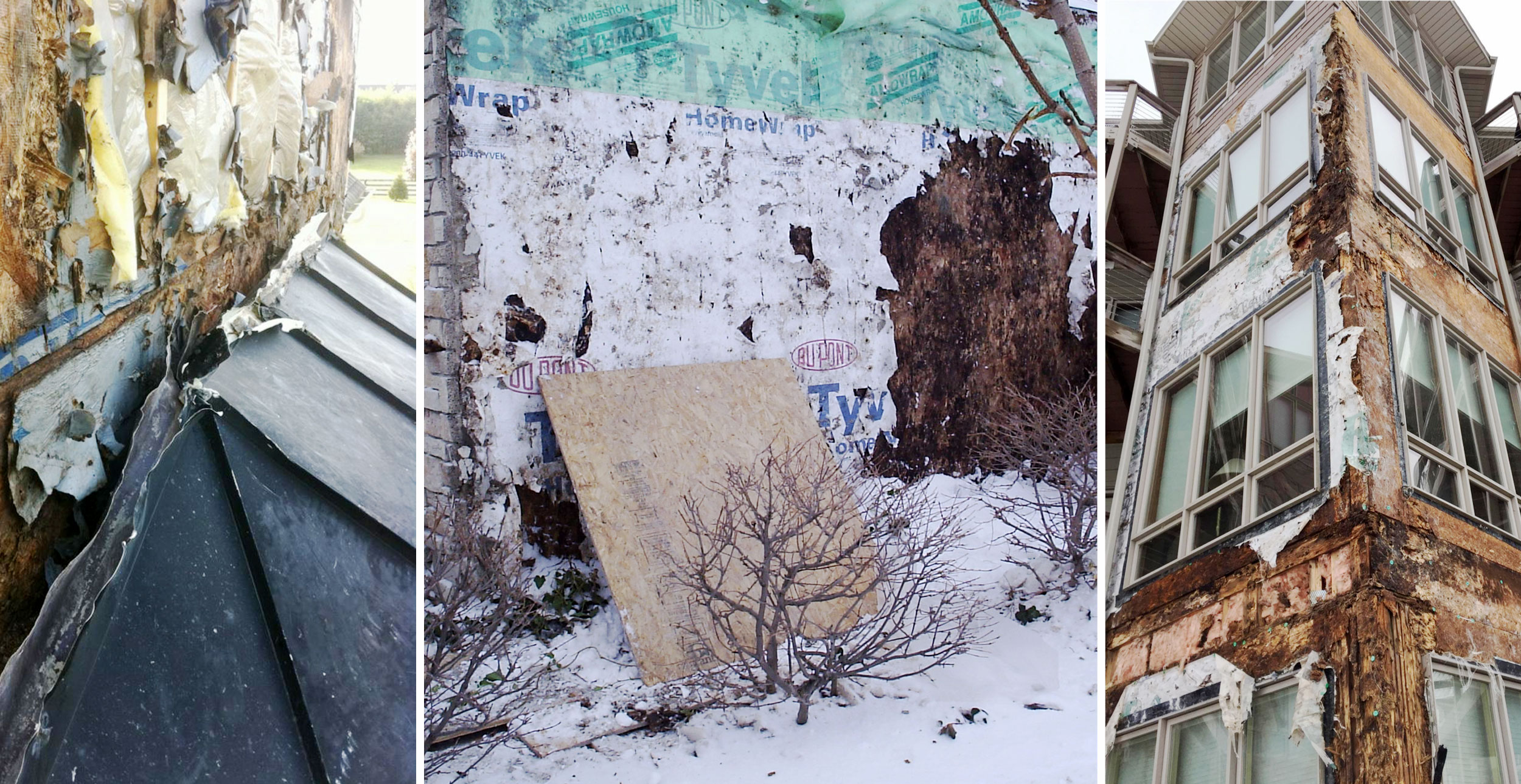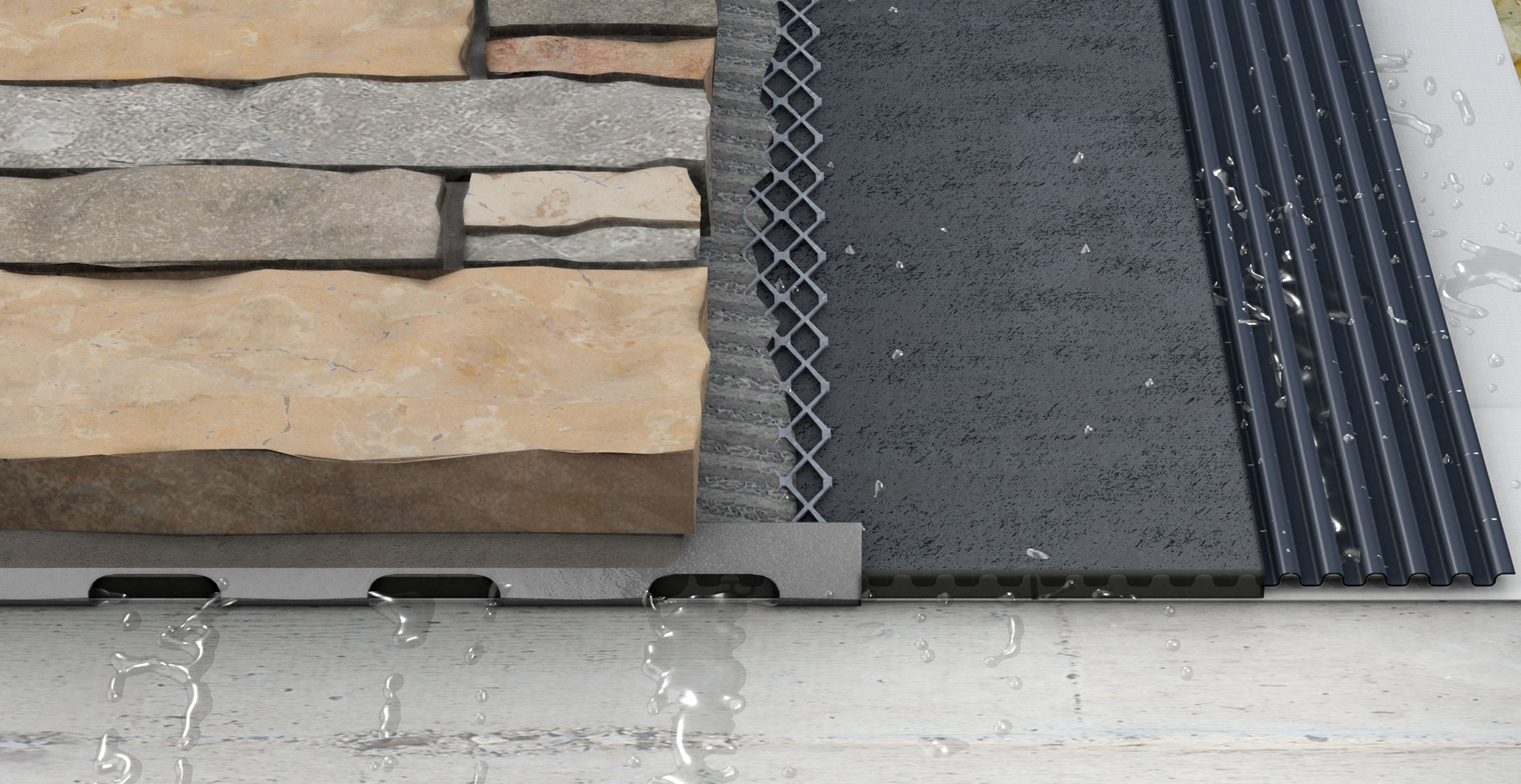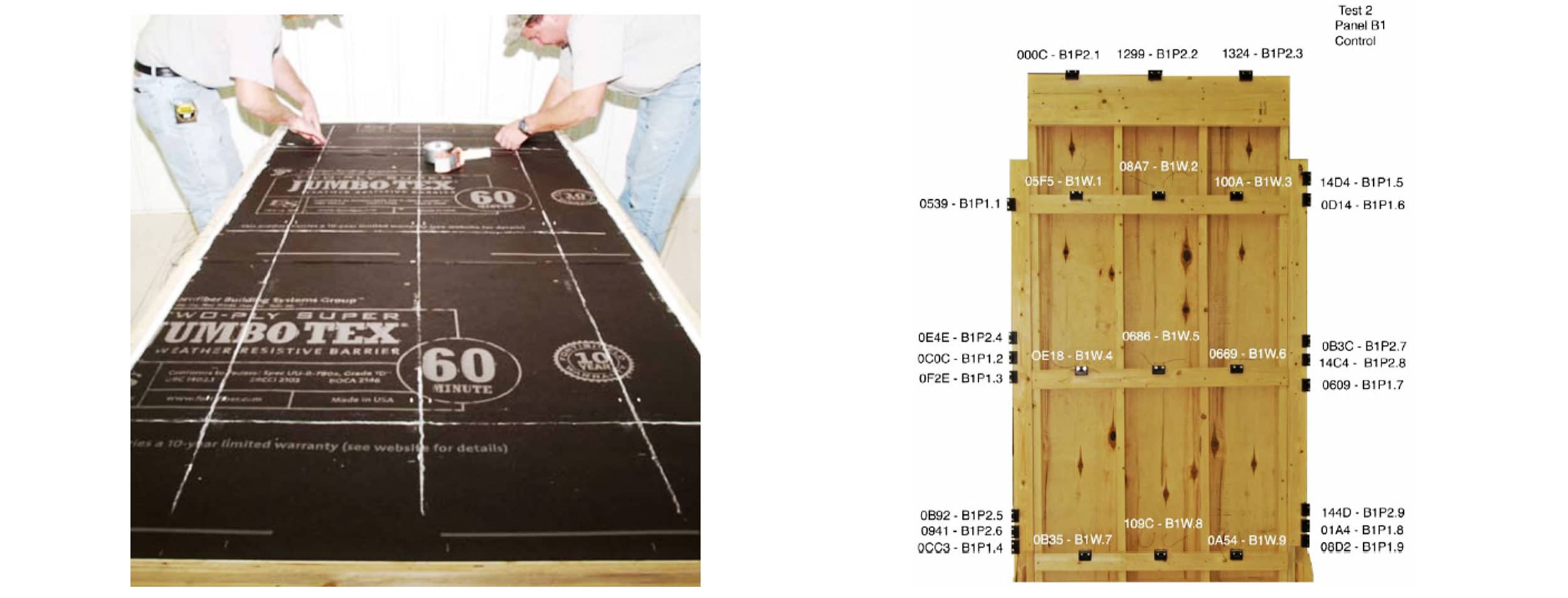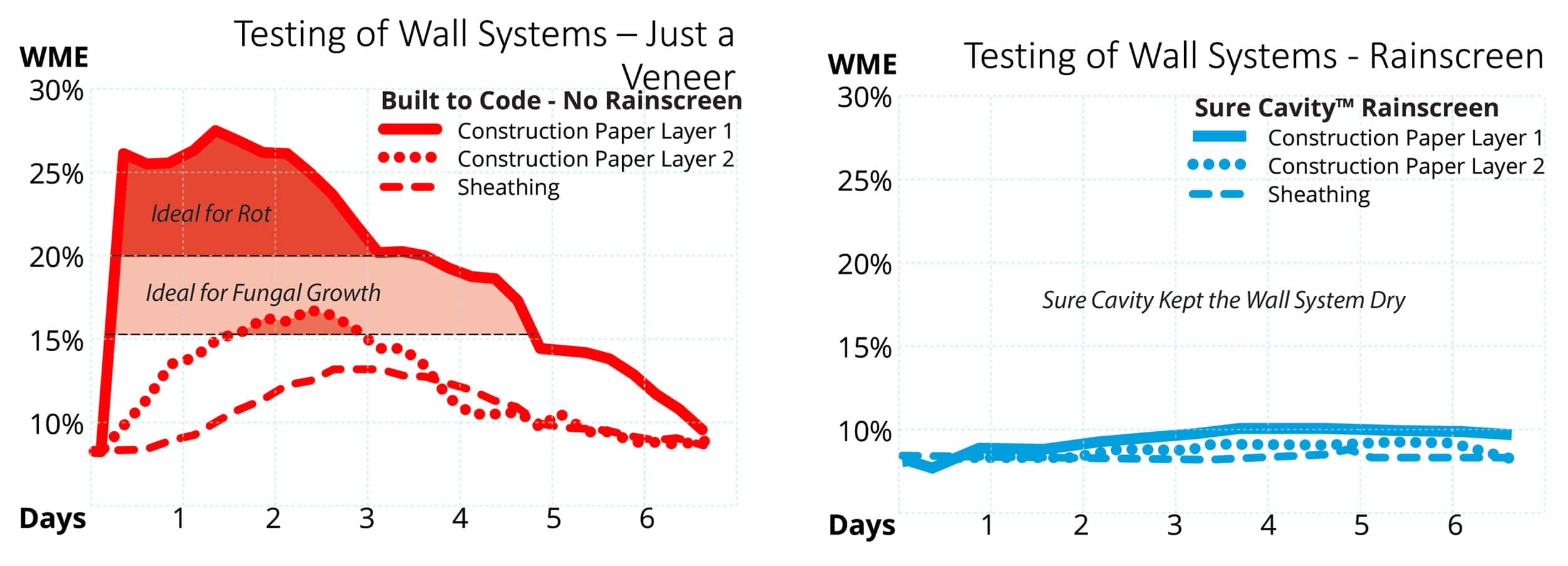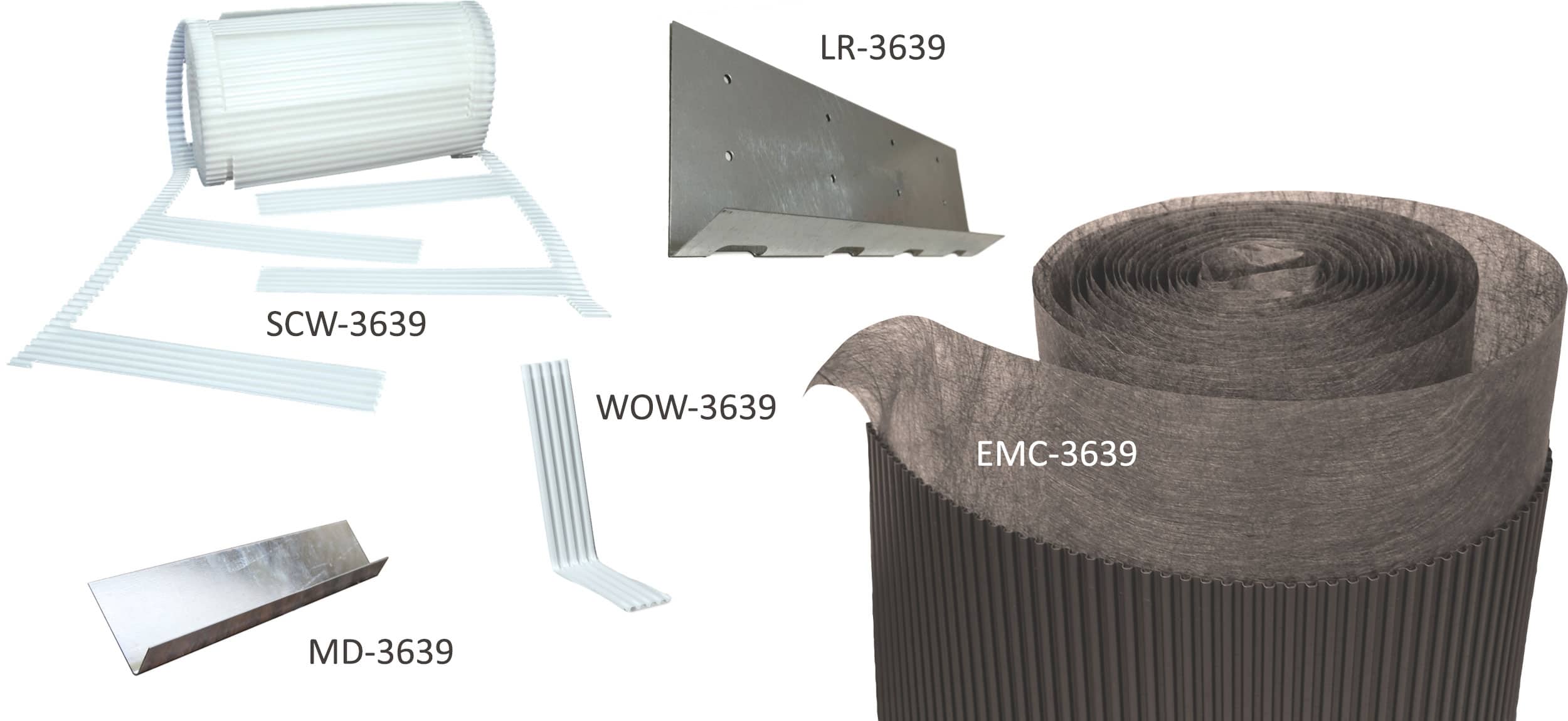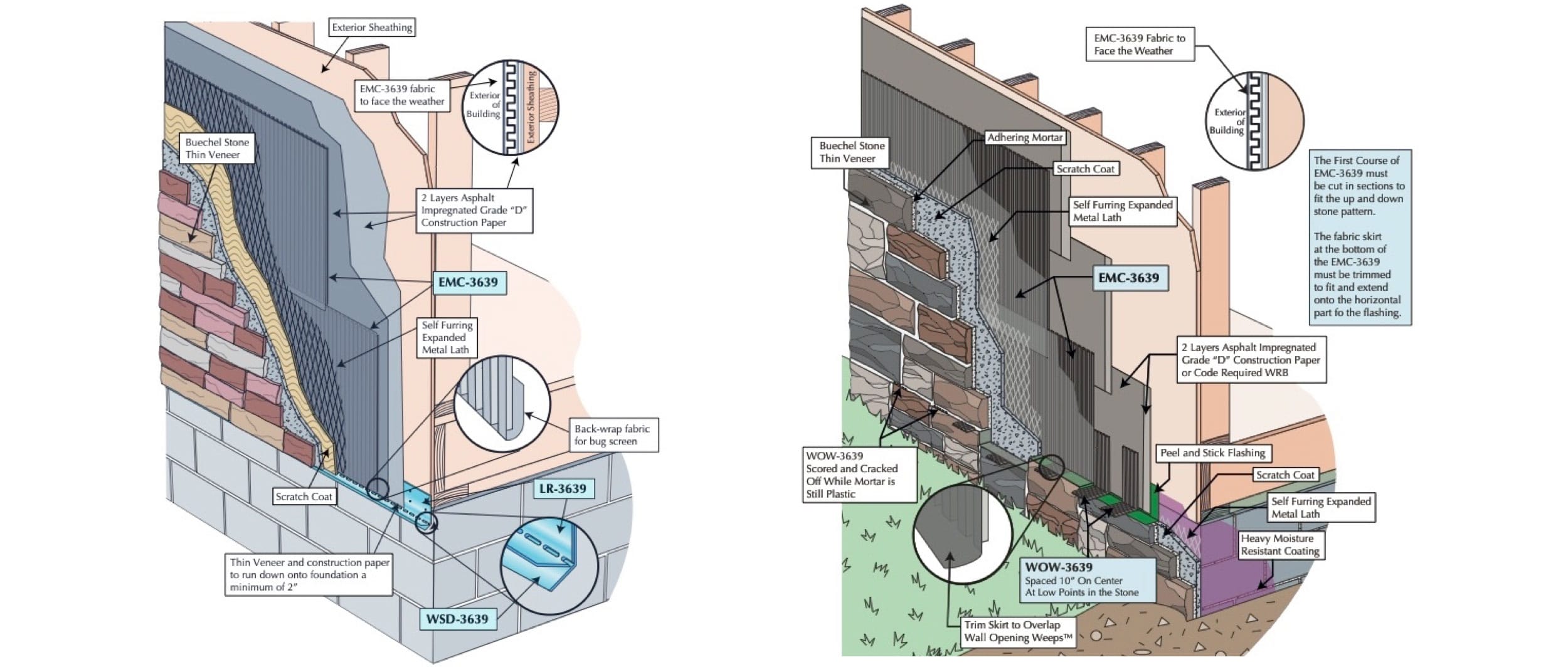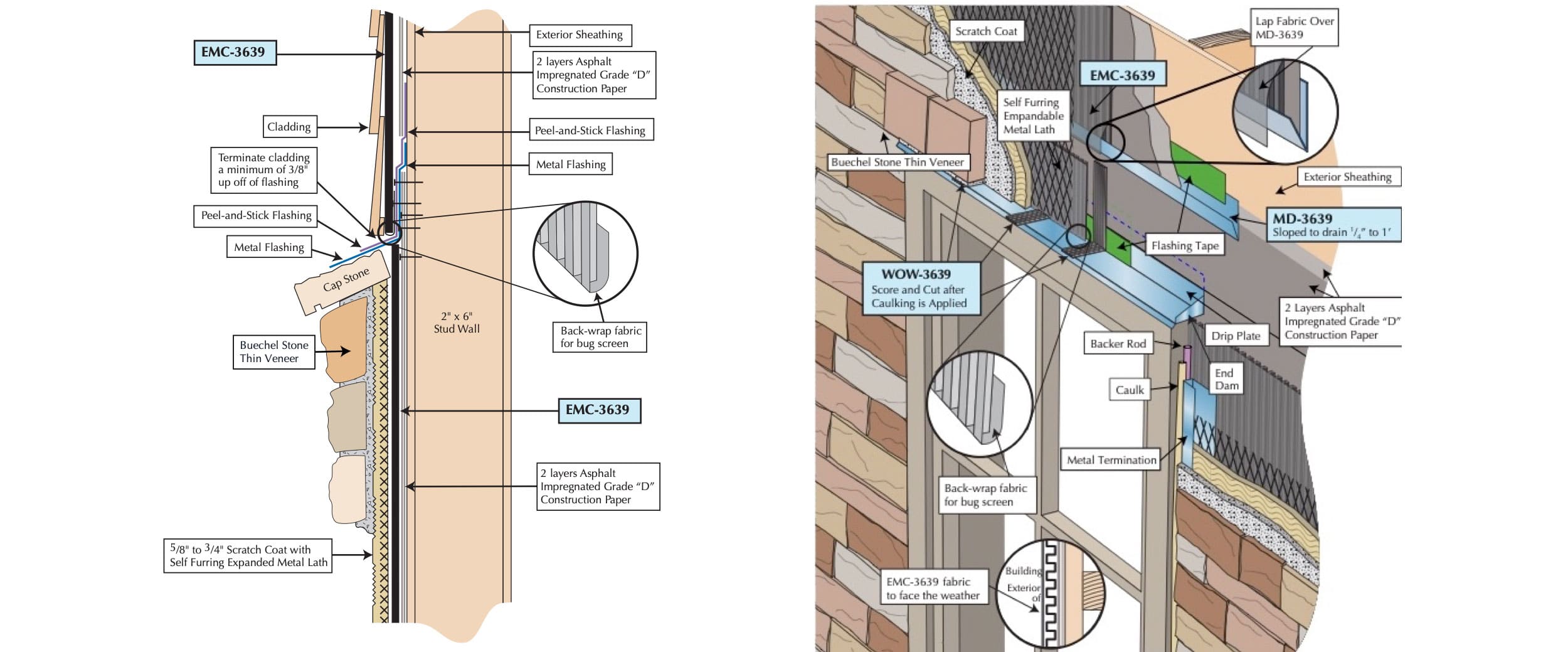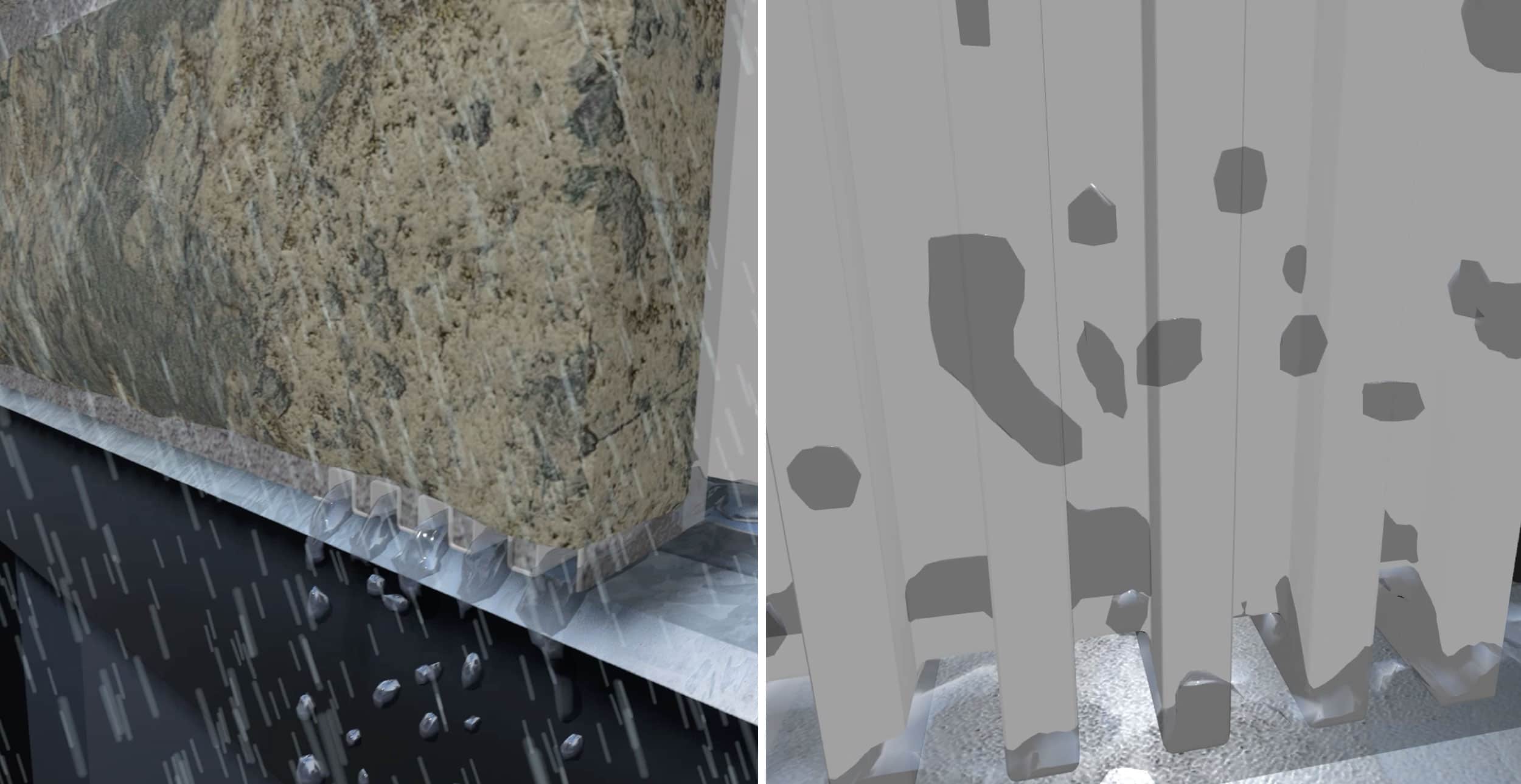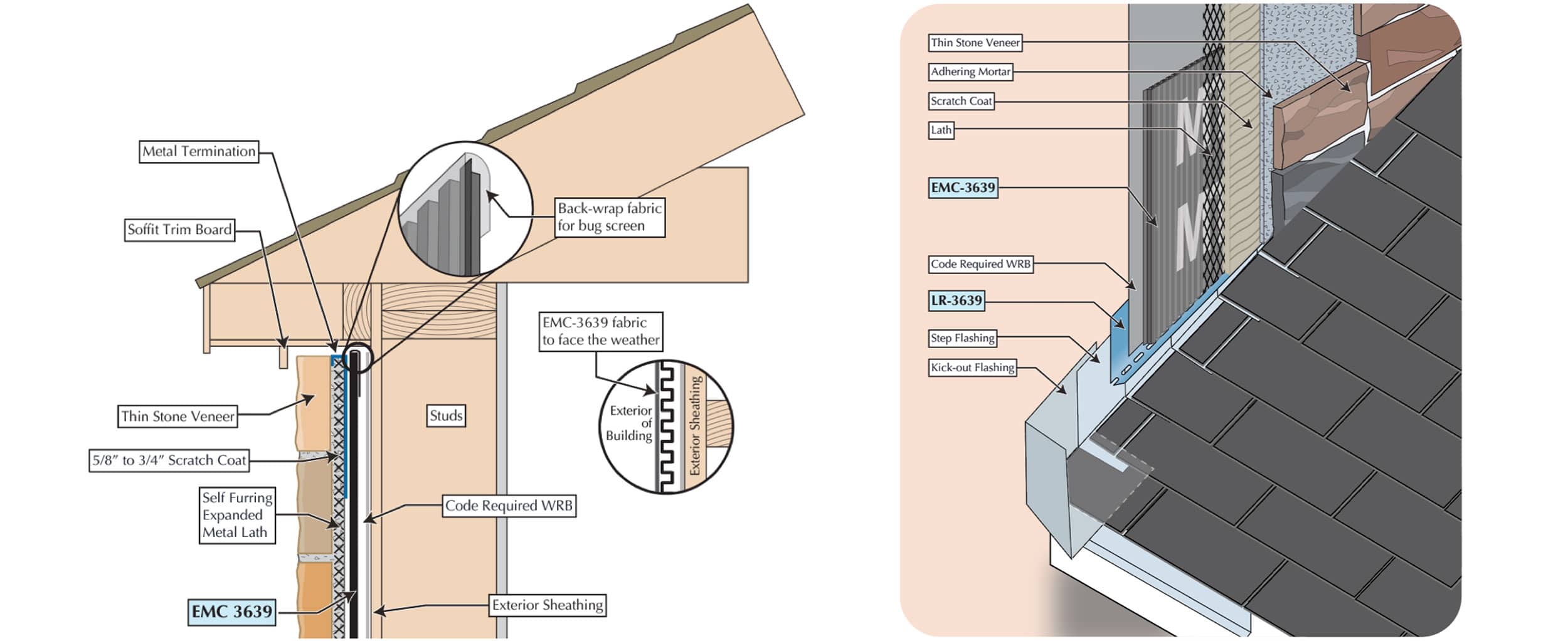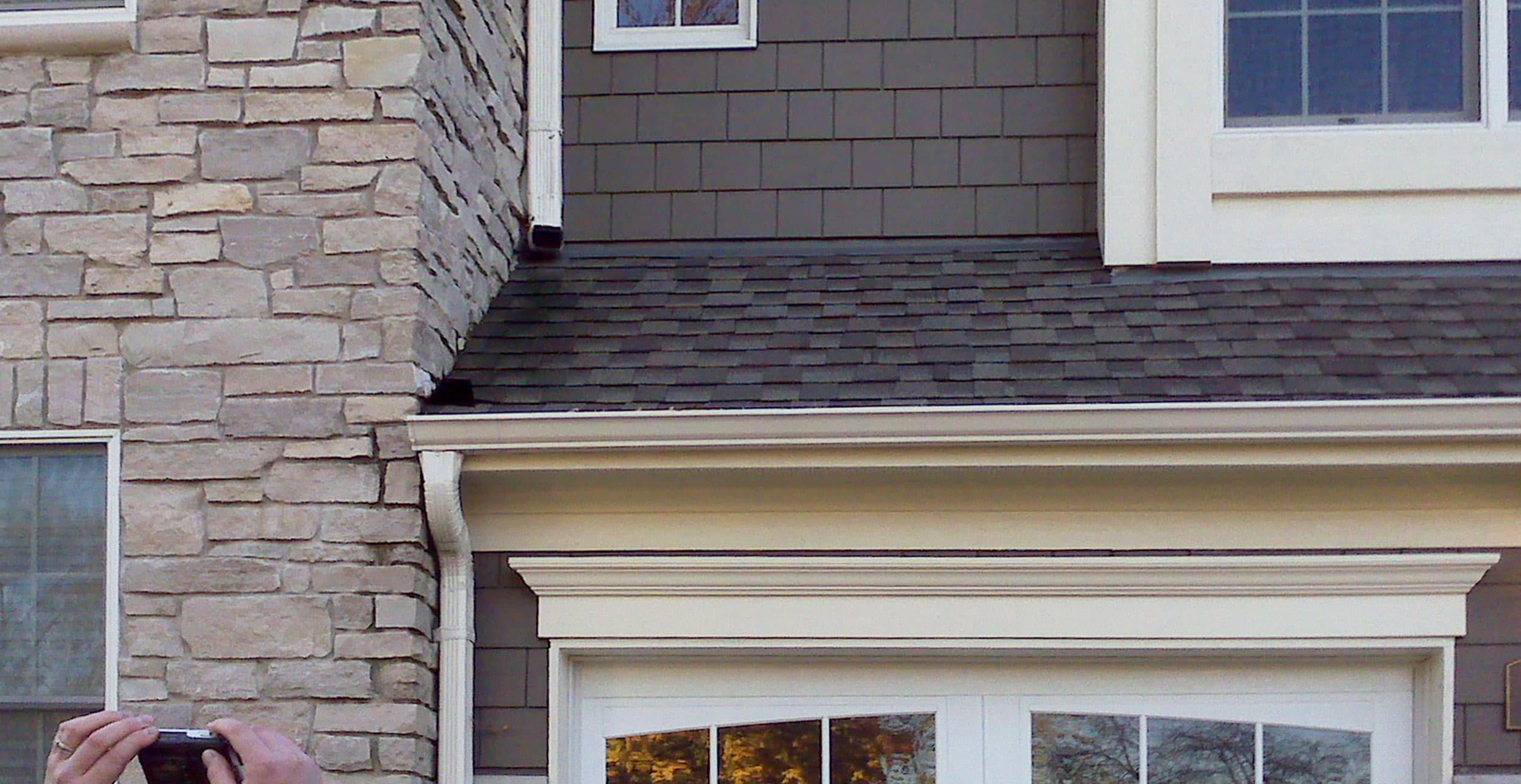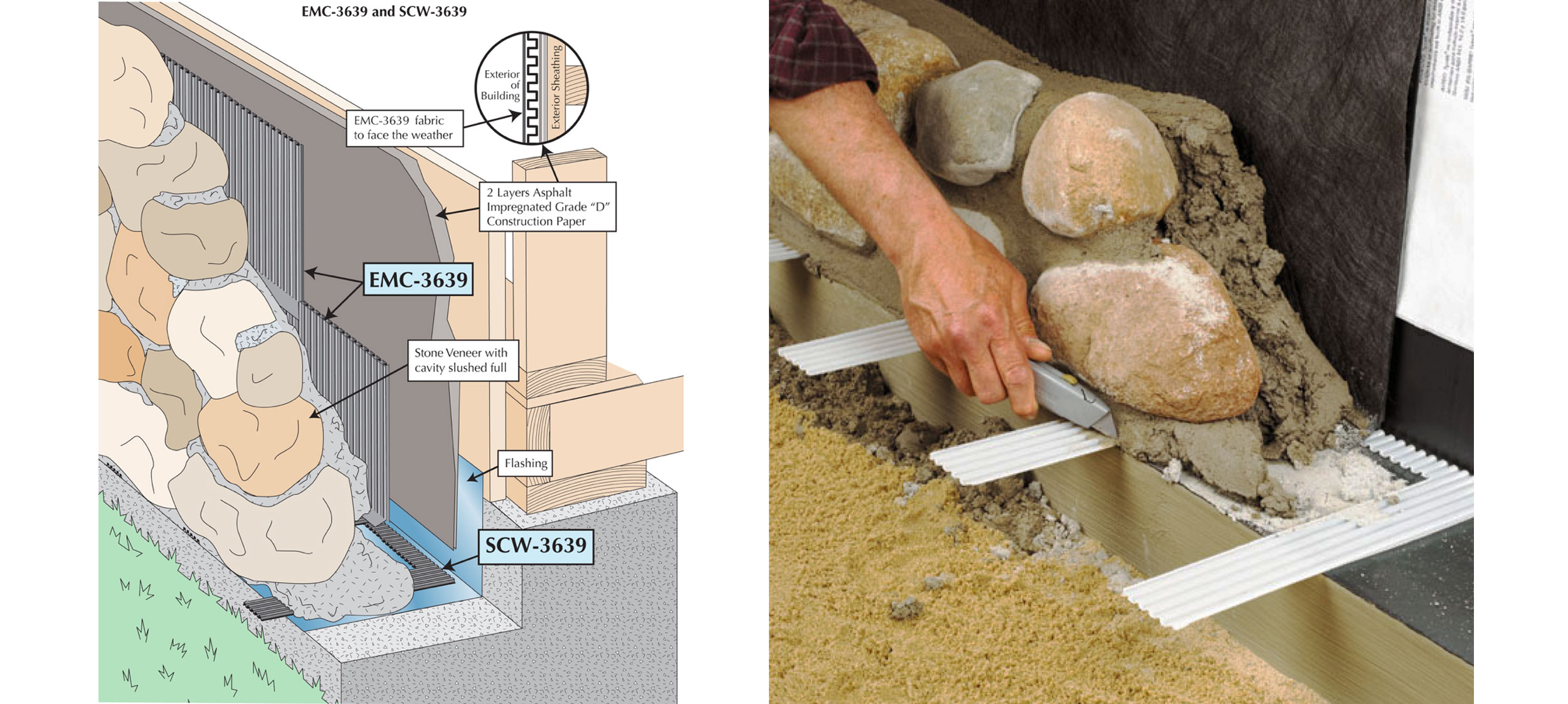Stucco, exterior insulation finish systems (EIFS), brick veneer, manufactured stone veneer, and cheap thin stone or faux stone siding often get bad reputations when it comes to installation defects in masonry construction because of improper moisture management. But even the best natural stone veneer, whether full or thin stone, is doomed to fail from water damage if moisture stays trapped in the wall. That’s why our staff of experts at Buechel Stone spent some time with Tyler LeClear Vachta, Marketing & Education Manager with Masonry Technology Inc., to learn more about how to prevent moisture problems with full and thin stone wall systems. He was so well-spoken on the topic that we requested his permission to pass along his expertise using his exact presentation, so that’s what we’re doing here. Watch his narrated video (embedded below) or scroll down this blog post to absorb the information at your own pace.
Moisture Management in Masonry Construction
This Press & Blog post looks at how to prevent moisture problems in full and thin stone veneer masonry construction. Flashings, building paper, and house wrap probably come to mind, and these are important components. But even with those materials, we’ve seen an increasing trend of failures. While EIFS and stucco get a bad reputation, stucco and thin stone face the exact same issues, and now with exterior rigid insulation behind stone we are re-creating the EIFS scenarios that led to trouble in the 90’s.
The photos above illustrate just some of the examples of failures in relatively new buildings, some of them less than a year old. We see house wrap and building paper. While sometimes there are obvious flaws in the detailing, there are cases where the assembly experienced normal wetting but just couldn’t dry. Over the years, we’ve seen many instances where an extra layer of building paper was added in an attempt to protect the wall. But a ‘belt and suspenders’ approach of adding another barrier doesn’t do very much.
The Harsh Reality of Moisture-related Stone Masonry Failures
Moisture problems are expensive too. Moisture-related failures make up the majority of warranty claims with the nation’s largest homebuilders. We can play the blame game, but the reality is that in these scenarios the only winners are the lawyers.
We need to digest a couple of realities. The first is that masonry is not waterproof, and most sidings aren’t. The second is that walls have always gotten wet, but if they dry out quick enough there is no problem. And finally, barrier products are imperfect. We know that building papers and house wraps break down if they sit in wet conditions over time. They have thousands of holes in them. But if there’s a gap for drainage, intentional or not, those barrier products won’t leak.
Here’s some perspective from builder and building scientist Peter Yost, “Things get wet, and heat dries them out. Energy efficiency measures reduce heat loss. So energy and moisture have to be managed with equal intensity.” I’ve certainly noticed a lot of energy related changes in the codes recently, but not much has changed with regard to moisture.
The Drying Power of Air Flow and Heat
When we think of drying something out, we think of it like putting wet clothes in a dryer. There are two forces that are drying those clothes out. One is air flow and the second is heat.
When we look at the changes to the building enclosure in the past twenty years, we’re really changed the air flow through the wall and the amount of insulation. Both of those changes have reduced the drying power in the wall. They’re not bad things, but they have consequences.
Another change that we’ve seen is that we are using more and more oriented strand board (OSB), which doesn’t dry very well and is more susceptible to mold than plywood. Also, we’re using water resistant barriers (WRBs), house wraps, and building papers that don’t do well when they are constantly wet.
A reality is that old, drafty walls dried out. And so older buildings are typically more durable. We don’t have to use old, drafty construction techniques in order to get durable walls. But since we’ve changed how we manage energy, we need to change how we manage moisture.
Enhanced Moisture Control (EMC) for Buechel Stone Veneers
As part of a solution, Buechel Stone offers an enhanced moisture control (EMC) system. This system is based on rain screen design, which creates an air gap between the facade and the house wrap or building paper. This rain screen design prevents wicking or capillary action. It drains liquid water using gravity. And it allows air flow to dry the assembly. This restores some of the drying power that we’ve taken out with the addition insulation and air sealing.
Thin Stone Veneer Moisture Control with EMC Components
The above image shows some of the EMC components. At the far right, we see the EMC-3639 drainage mat, with vertical channels and mortar-blocking fabric. (There are two sizes on the Buechel website, linked here: EMC-3639 and EMC-3639XL.) The vertical channels allow moisture to drain to the bottom of the wall and exit. And the mortar-blocking fabric protects those channels so that the mortar doesn’t clog them. The fabric is also wrapped around the back so that we have an insect guard at terminations.
At the bottom, you can see a LR-3639 WEEP screed, made of galvanized steel. This WEEP screed is a little different. There’s large slots to drain liquid water and allow air flow to ventilate the rain screen air gap. An air gap is allowed by code to replace the outer layer of building paper or house wrap. (Please verify with local codes.)
Testing of Rain Screen Natural Stone Wall Systems
Testing shows that rain screen systems perform significantly better than code-minimum systems. The above lab test compared a code-minimum wall with two layers of paper, lathe, and scratch coat to a system with the building paper, rain screen drainage mat, lathe, and scratch coat. Moisture sensors were embedded on the face of the sheathing and each layer of paper to measure moisture over time.
Code-minimum vs. Rain Screen Test Results – Veneer Stone Wall Systems
When the code-minimum system with two layers of paper was sprayed, the layers got wet and stayed wet for days in dangerous levels that promote rot and fungal growth. (Test results in red on upper left above.) But with the rain screen system, the layers simply didn’t get wet. (Test results in blue on upper right above.)
Enhanced Moisture Control (EMC) Rain Screen Components – Full & Thin Stone Veneers
So let’s look at the components a little closer, and then we’ll get to detailing in just a minute. The full wall air gap over the building paper or house wrap, is maintained by the EMC-3639 which is vapor-open to allow the system to dry to the exterior.
At the base of the wall, we need to let liquid water exit. With full width stone veneer, we can use the SCW-3639 or WOW-3639. They both create tunnels for drainage on the flashing. They work better than rope WEEPs, which don’t wick very well, or tube and vents that end up above the bed joint mortar.
With adhered stone we can use the WOW-3639 or the LR-3639 WEEP screed, which has large slots for drainage and ventilation.
Any time that we have an interruption in the drainage plane, such as at a window or door, we need to let the water escape or divert it. The WOW-3639 WEEP is used on window drip cap flashings to let the water exit the wall in full or thin stone veneer. The MD-3639, or moisture diverter, can be used to divert moisture from the drainage plane away from the rough opening in inset applications, or as a ‘belt and suspenders’ approach with the WEEPs.
Enhanced Moisture Control (EMC) – Thin Stone Masonry Installation Base Details
Now we’re going to take a look at some of the more common details. On the left (below) we have our base detail. EMC-3639 drainage mat is installed over the building paper with a hammer tacker and terminates in the LR-3639 WEEP screed. The mortar blocking fabric faces you as you install it. At the base of the wall, back-wrap the fabric to create a bug screen. On subsequent courses, the plastic gets butted and the fabric gets lapped over the courses below.
On the right (above) we have a run-to-grade detail for a premium appearance with natural thin stone veneer running all of the way to grade. Here a flashing line is created with flexible flashing, and WOW-3639 WEEPs are installed 10 inches on center, at the low points in the flashing. The EMC-3639 is installed over the top, with the fabric lapping over the WEEPs. Trim the excess fabric to not protrude from the veneer stone wall. Install the lathe, scratch coat, and stone veneer. When the joint mortar is thumbprint-hard, score and snap off the WEEPs at the face of the wall, and brush the joints.
Enhanced Moisture Control (EMC) – Thin Stone Install Siding Transition & Window Detail
Another common detail is a stone siding transition. The EMC-3639 can also be used behind siding. At transitions such as a stone wainscoting, flash the upper detail at the cap stone.
On the right (above) we have a window detail. At windows, install the WOW-3639 WEEP above the drip plate with the EMC-3639 fabric lapping over the WEEPs. This prevents the mortar from clogging the WEEPs. On inset windows where WEEPs are not practical, use the MD-3639 moisture diverter to divert moisture away from the opening. Install the MD-3639 at a quarter inch per foot slope to drain immediately above the opening. Extend it four inches beyond the opening on both sides. Terminate the EMC-3639 in the moisture diverter.
The above image shows how moisture can drain from the WOW-3639 on the drip cap flashing.
Here is an example (above) of the moisture diverter installed above an inset window. Flashing tape is used to integrate the moisture diverter with the house wrap. Once the thin brick or thin stone veneer is installed, the moisture diverter is completely concealed.
Enhanced Moisture Control (EMC) – Thin Stone Veneer Masonry Installation Soffit Details
Two other important details include the soffit (pictured below). For maximum drying, we want to vent the EMC-3639 below the soffit. Leave a small gap for ventilation between the termination and the soffit board. Use a soffit trim board to protect against wind-driven rain.
On the right (above) we have a wall-to-roof intersection with a very important masonry installation detail. The kick-out flashing used in this detail is a fifteen-dollar piece of metal or plastic that can prevent $30,000 dollars in repairs.
We can see (in the above image) that the stone below the roof-wall intersection has gotten very wet over time and trouble is lurking beneath. Use a kick-out flashing in a place like this.
Enhanced Moisture Control (EMC) – Full-width Stone Veneer Masonry Installation Base Detail
Most of the details that we looked at will work in a full or thin stone veneer application. The one major difference is the base detail in a full-width stone masonry application.
Here the SCW-3639 is rolled out on the flashing. This is a self-spaced WEEP that puts WEEPs every ten inches on center. Roll out the product, lay the bed joint and mortar in the masonry units; and when the mortar is thumbprint-hard score the WEEPs with a utility knife at the face of the wall. Push down to snap off the WEEPs. And brush tool the mortar joints. The WOW-3639 can also be used here.
Shortlist of Reminders to Recap EMC for Full & Thin Stone Veneer Masonry Construction
Let’s do a quick recap. We know that sitting, trapped water deteriorates the water resistance of building papers, house wraps, and flashing materials. We need to use physics. Slope and a space for drainage can prevent entrapped water. Another important reminder is that a wall is vertical. Any “wall” that isn’t vertical should be treated like a roof. Building papers and house wraps have thousands of holes in them. If there is a gap for drainage, we know that they don’t leak. And roof intersections absolutely need a kick-out flashing to divert moisture away from the wall below.
Best Experiences with Buechel Stone Every Step of the Way
Whether you buy stone veneer (full or thin stone masonry) or any other variety of natural stone products from our carefully curated collections, know that Buechel Stone will be there to ensure best experiences through every step of the process. Visit the installation accessories pages of the Buechel Stone website or the installation details file box on our resources page to view and/or download detail drawings. You can also get in contact with your Buechel Stone rep for answers to your moisture management questions – we’d love to hear from you. JOIN OUR NEWSLETTER or follow us on your favorite social media platform (Facebook, LinkedIn, Twitter, YouTube, Pinterest) to be notified of everything we’re doing to inspire a future built on natural stone project successes. Because quality products and access to expertise to construct buildings that last is just part of what we’re about. And providing best experiences is what gets us out of bed every morning – making Buechel Stone your ONLY REAL CHOICE in STONE.
Tracy Lisowe
Marketing Director
Buechel Stone Corp.
*Note: In follow up to this post, in May of 2019 we updated our leave-behind brochure. (Click here for download tab and printable version of our Enhanced Moisture Control (EMC) brochure.)
